University Change Proposal Report: Education Inequality in Australia
VerifiedAdded on 2023/06/01
|10
|2128
|449
Report
AI Summary
This report presents a change proposal addressing educational inequality in Australia. It identifies the issue of disparities among students from different socioeconomic backgrounds, leading to underachievement and social exclusion. The proposal suggests amending educational policies to support disadvantaged students, reduce resource gaps between schools, and ensure an even distribution of the student population. The report analyzes the feasibility of the proposal using PEST and SWOT analyses, considering political, economic, social, and technological factors, as well as strengths, weaknesses, opportunities, and threats. The conclusion emphasizes the need for changes to bridge the gap between advantaged and disadvantaged schools and ensure equal access to educational resources and opportunities for all students in Australia. The report provides a detailed analysis of the current educational policies and their impact on the students, and offers viable solutions to address the inequalities.
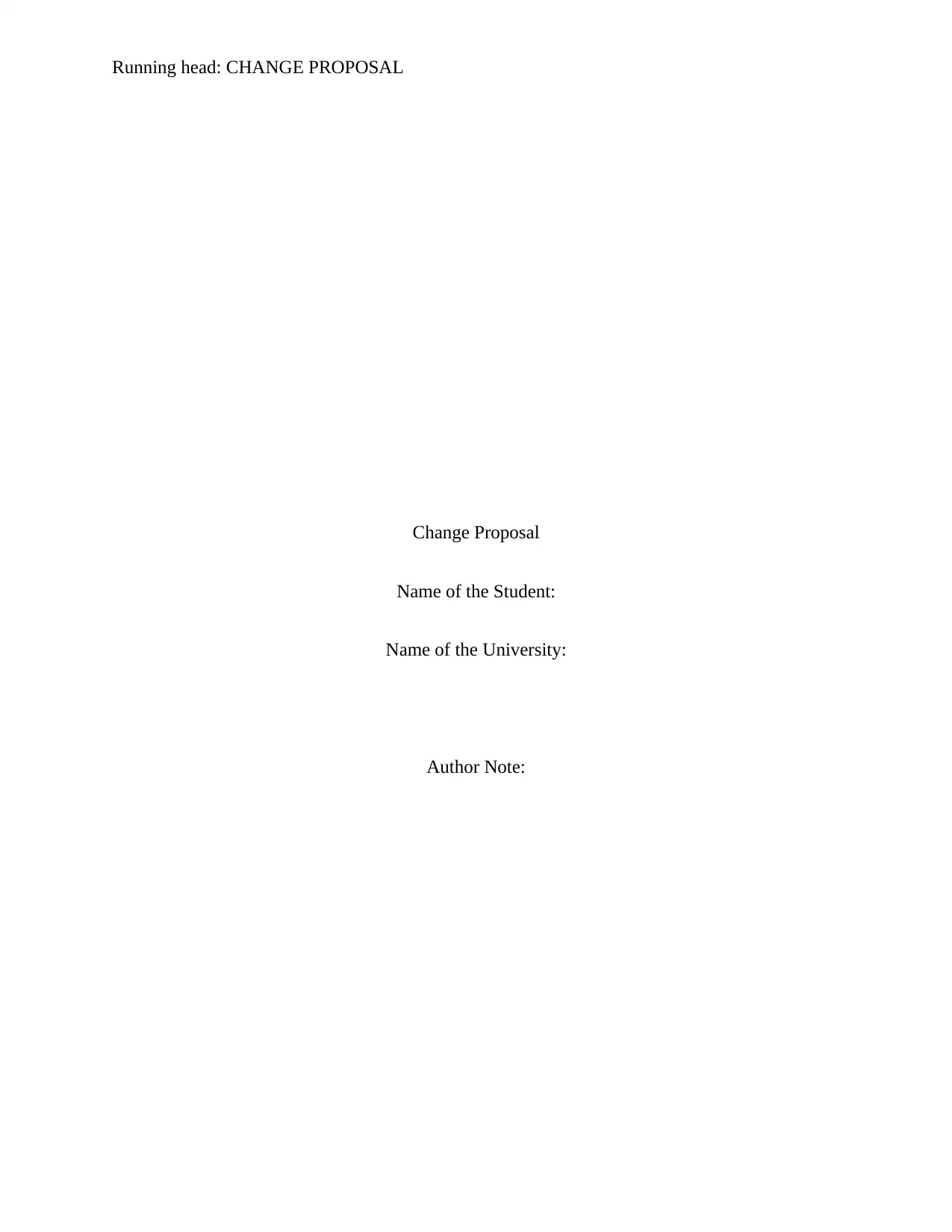
Running head: CHANGE PROPOSAL
Change Proposal
Name of the Student:
Name of the University:
Author Note:
Change Proposal
Name of the Student:
Name of the University:
Author Note:
Paraphrase This Document
Need a fresh take? Get an instant paraphrase of this document with our AI Paraphraser
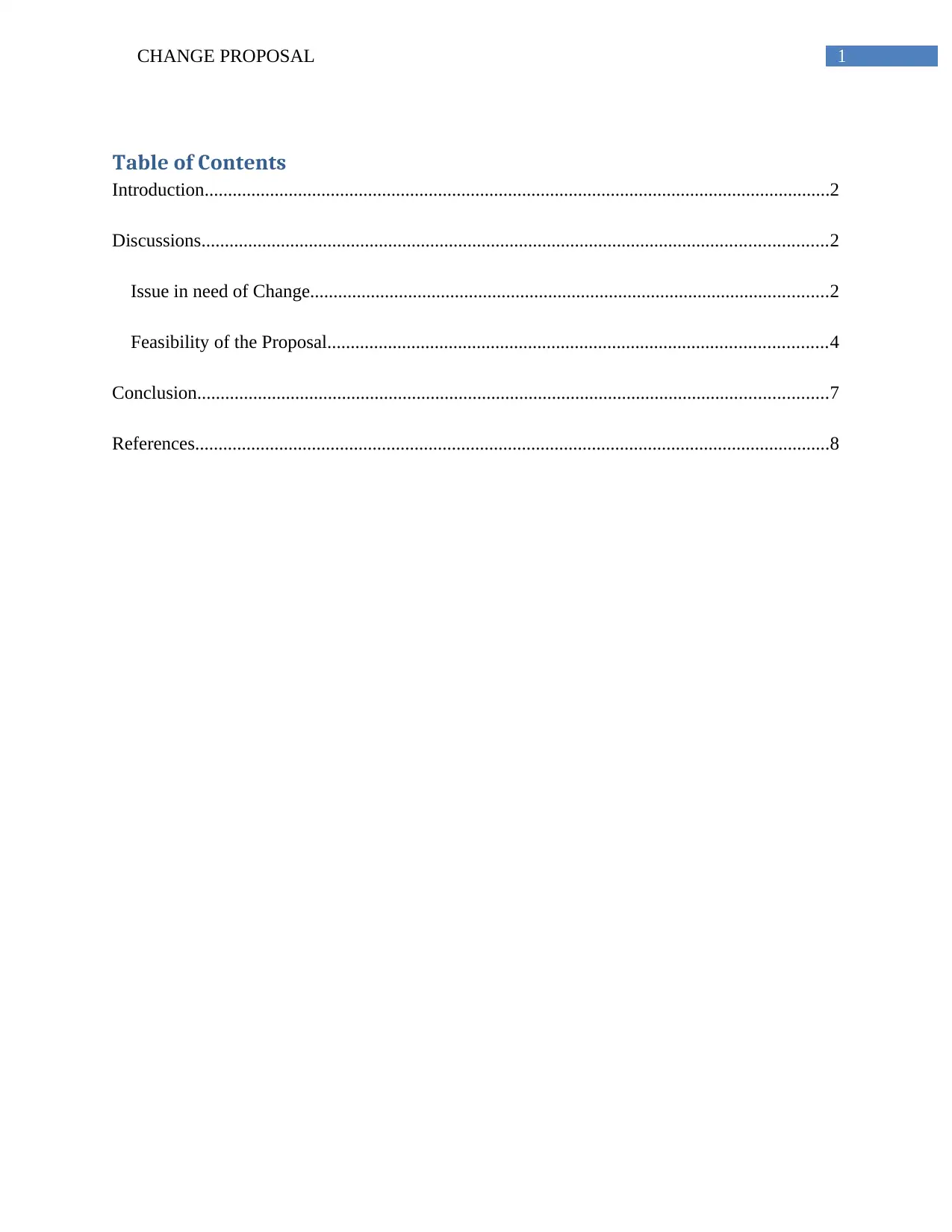
1CHANGE PROPOSAL
Table of Contents
Introduction......................................................................................................................................2
Discussions......................................................................................................................................2
Issue in need of Change...............................................................................................................2
Feasibility of the Proposal...........................................................................................................4
Conclusion.......................................................................................................................................7
References........................................................................................................................................8
Table of Contents
Introduction......................................................................................................................................2
Discussions......................................................................................................................................2
Issue in need of Change...............................................................................................................2
Feasibility of the Proposal...........................................................................................................4
Conclusion.......................................................................................................................................7
References........................................................................................................................................8
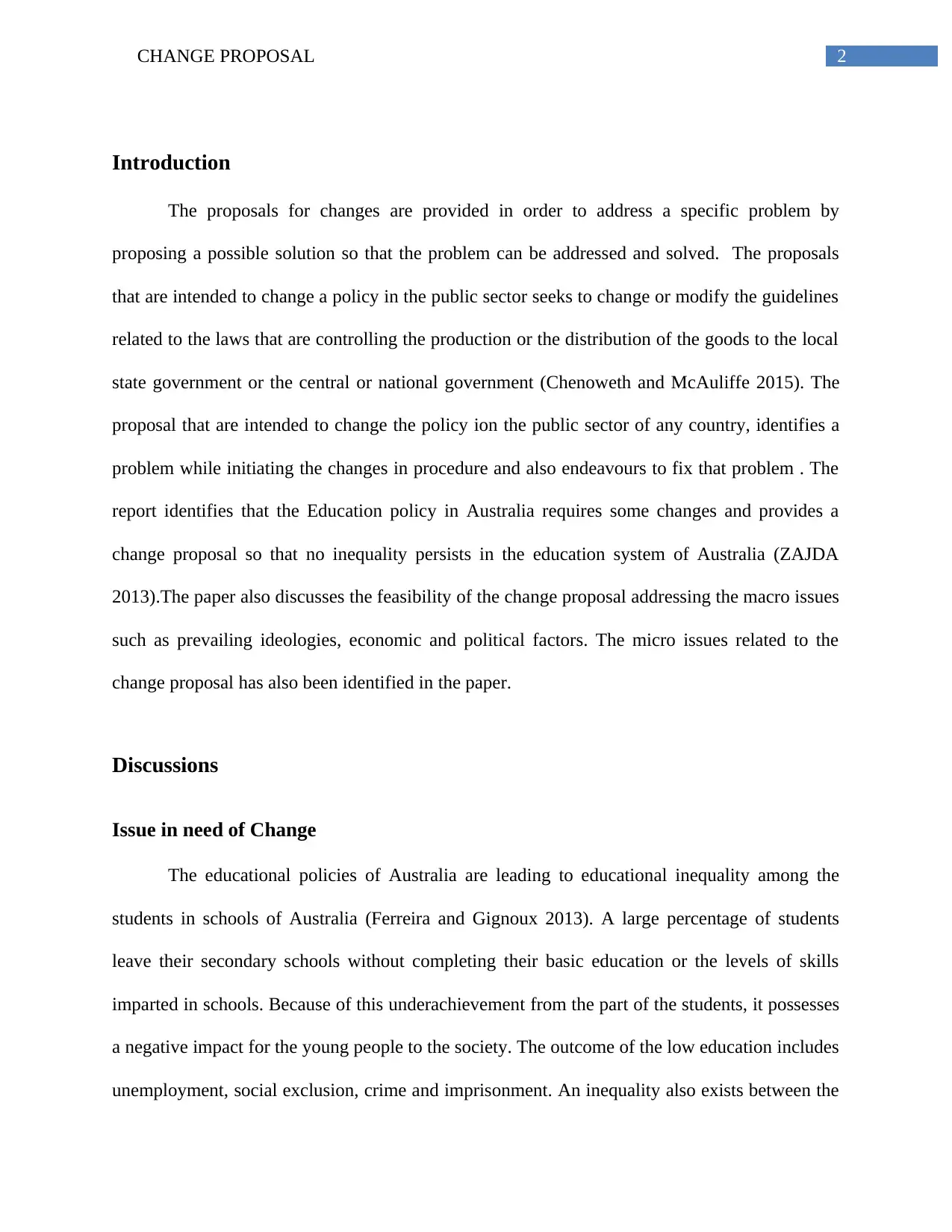
2CHANGE PROPOSAL
Introduction
The proposals for changes are provided in order to address a specific problem by
proposing a possible solution so that the problem can be addressed and solved. The proposals
that are intended to change a policy in the public sector seeks to change or modify the guidelines
related to the laws that are controlling the production or the distribution of the goods to the local
state government or the central or national government (Chenoweth and McAuliffe 2015). The
proposal that are intended to change the policy ion the public sector of any country, identifies a
problem while initiating the changes in procedure and also endeavours to fix that problem . The
report identifies that the Education policy in Australia requires some changes and provides a
change proposal so that no inequality persists in the education system of Australia (ZAJDA
2013).The paper also discusses the feasibility of the change proposal addressing the macro issues
such as prevailing ideologies, economic and political factors. The micro issues related to the
change proposal has also been identified in the paper.
Discussions
Issue in need of Change
The educational policies of Australia are leading to educational inequality among the
students in schools of Australia (Ferreira and Gignoux 2013). A large percentage of students
leave their secondary schools without completing their basic education or the levels of skills
imparted in schools. Because of this underachievement from the part of the students, it possesses
a negative impact for the young people to the society. The outcome of the low education includes
unemployment, social exclusion, crime and imprisonment. An inequality also exists between the
Introduction
The proposals for changes are provided in order to address a specific problem by
proposing a possible solution so that the problem can be addressed and solved. The proposals
that are intended to change a policy in the public sector seeks to change or modify the guidelines
related to the laws that are controlling the production or the distribution of the goods to the local
state government or the central or national government (Chenoweth and McAuliffe 2015). The
proposal that are intended to change the policy ion the public sector of any country, identifies a
problem while initiating the changes in procedure and also endeavours to fix that problem . The
report identifies that the Education policy in Australia requires some changes and provides a
change proposal so that no inequality persists in the education system of Australia (ZAJDA
2013).The paper also discusses the feasibility of the change proposal addressing the macro issues
such as prevailing ideologies, economic and political factors. The micro issues related to the
change proposal has also been identified in the paper.
Discussions
Issue in need of Change
The educational policies of Australia are leading to educational inequality among the
students in schools of Australia (Ferreira and Gignoux 2013). A large percentage of students
leave their secondary schools without completing their basic education or the levels of skills
imparted in schools. Because of this underachievement from the part of the students, it possesses
a negative impact for the young people to the society. The outcome of the low education includes
unemployment, social exclusion, crime and imprisonment. An inequality also exists between the
⊘ This is a preview!⊘
Do you want full access?
Subscribe today to unlock all pages.

Trusted by 1+ million students worldwide
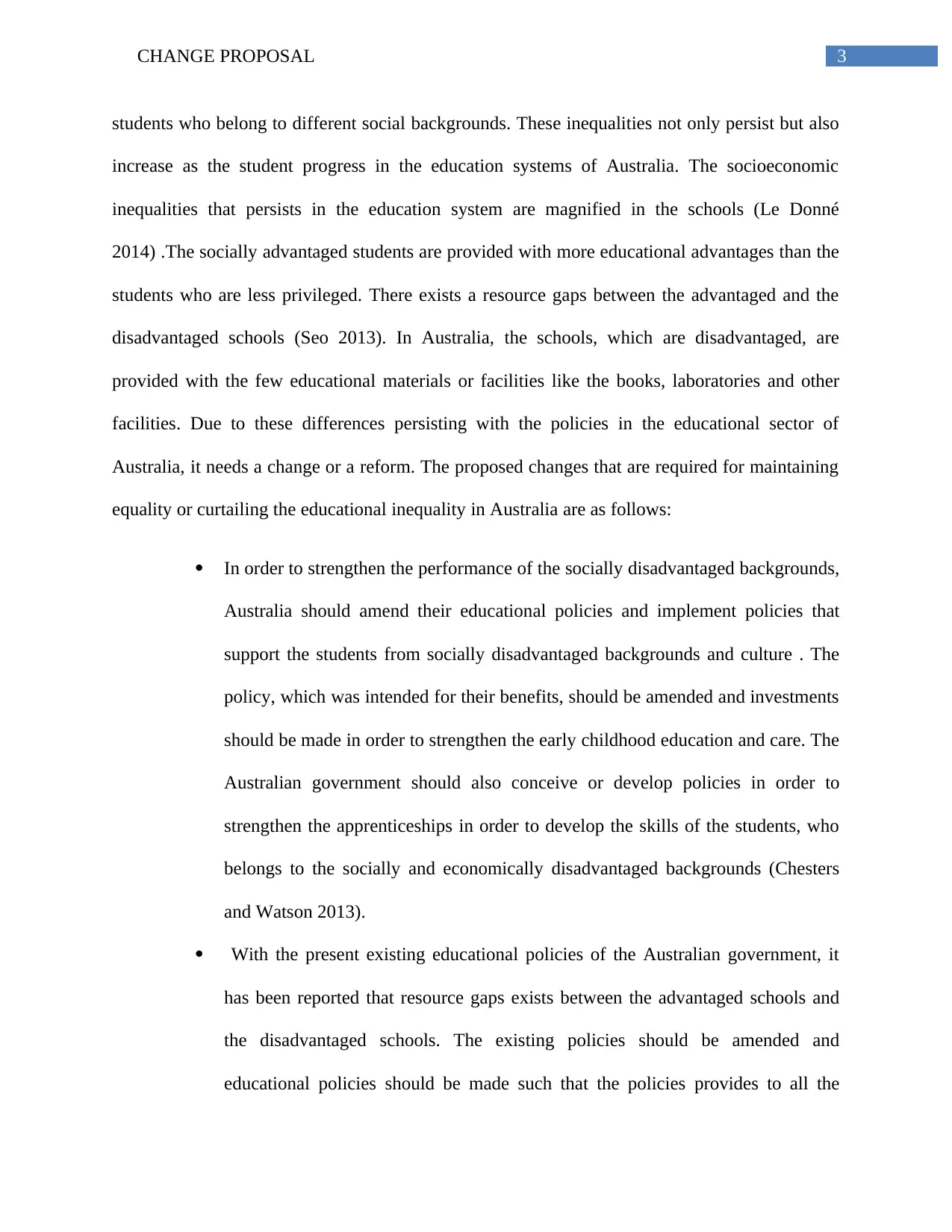
3CHANGE PROPOSAL
students who belong to different social backgrounds. These inequalities not only persist but also
increase as the student progress in the education systems of Australia. The socioeconomic
inequalities that persists in the education system are magnified in the schools (Le Donné
2014) .The socially advantaged students are provided with more educational advantages than the
students who are less privileged. There exists a resource gaps between the advantaged and the
disadvantaged schools (Seo 2013). In Australia, the schools, which are disadvantaged, are
provided with the few educational materials or facilities like the books, laboratories and other
facilities. Due to these differences persisting with the policies in the educational sector of
Australia, it needs a change or a reform. The proposed changes that are required for maintaining
equality or curtailing the educational inequality in Australia are as follows:
In order to strengthen the performance of the socially disadvantaged backgrounds,
Australia should amend their educational policies and implement policies that
support the students from socially disadvantaged backgrounds and culture . The
policy, which was intended for their benefits, should be amended and investments
should be made in order to strengthen the early childhood education and care. The
Australian government should also conceive or develop policies in order to
strengthen the apprenticeships in order to develop the skills of the students, who
belongs to the socially and economically disadvantaged backgrounds (Chesters
and Watson 2013).
With the present existing educational policies of the Australian government, it
has been reported that resource gaps exists between the advantaged schools and
the disadvantaged schools. The existing policies should be amended and
educational policies should be made such that the policies provides to all the
students who belong to different social backgrounds. These inequalities not only persist but also
increase as the student progress in the education systems of Australia. The socioeconomic
inequalities that persists in the education system are magnified in the schools (Le Donné
2014) .The socially advantaged students are provided with more educational advantages than the
students who are less privileged. There exists a resource gaps between the advantaged and the
disadvantaged schools (Seo 2013). In Australia, the schools, which are disadvantaged, are
provided with the few educational materials or facilities like the books, laboratories and other
facilities. Due to these differences persisting with the policies in the educational sector of
Australia, it needs a change or a reform. The proposed changes that are required for maintaining
equality or curtailing the educational inequality in Australia are as follows:
In order to strengthen the performance of the socially disadvantaged backgrounds,
Australia should amend their educational policies and implement policies that
support the students from socially disadvantaged backgrounds and culture . The
policy, which was intended for their benefits, should be amended and investments
should be made in order to strengthen the early childhood education and care. The
Australian government should also conceive or develop policies in order to
strengthen the apprenticeships in order to develop the skills of the students, who
belongs to the socially and economically disadvantaged backgrounds (Chesters
and Watson 2013).
With the present existing educational policies of the Australian government, it
has been reported that resource gaps exists between the advantaged schools and
the disadvantaged schools. The existing policies should be amended and
educational policies should be made such that the policies provides to all the
Paraphrase This Document
Need a fresh take? Get an instant paraphrase of this document with our AI Paraphraser
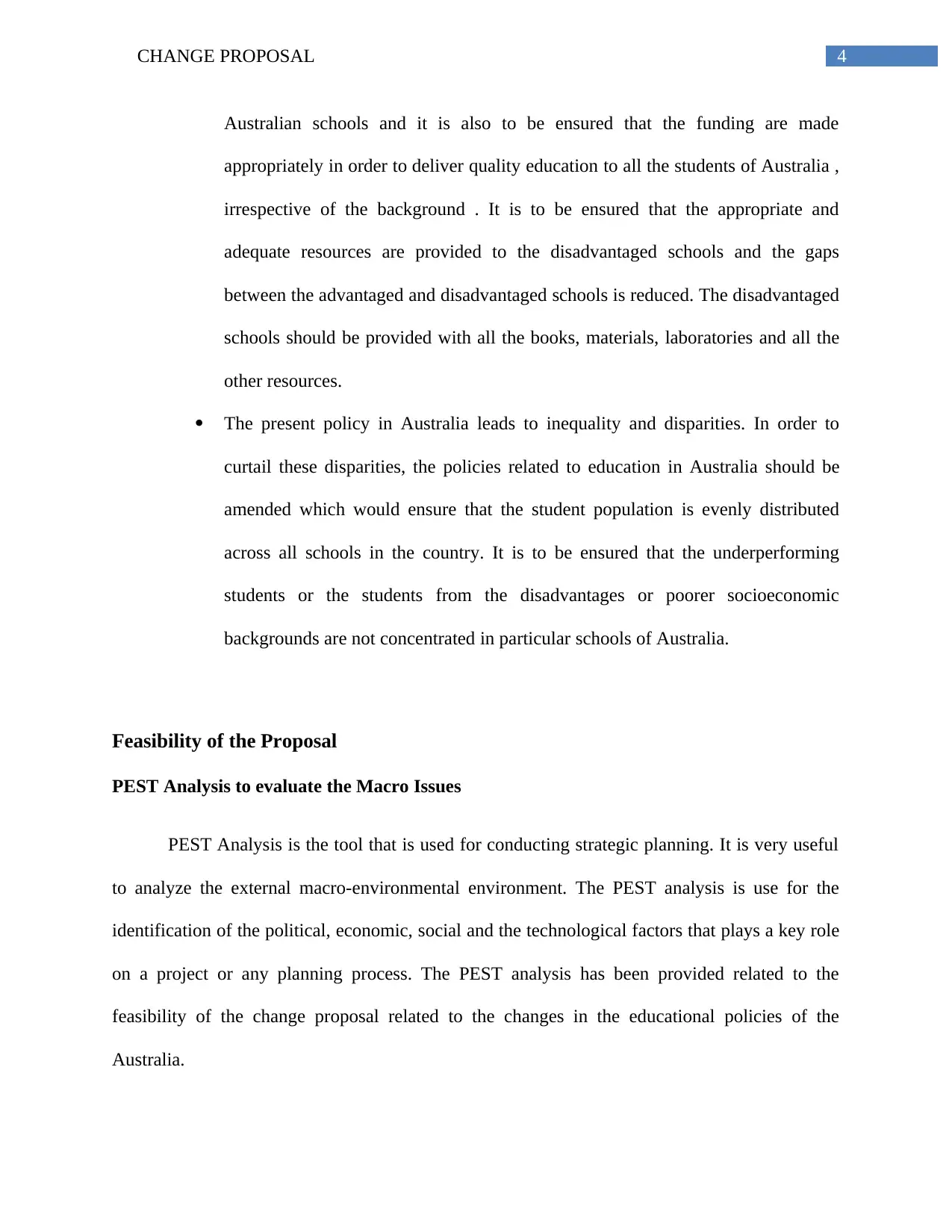
4CHANGE PROPOSAL
Australian schools and it is also to be ensured that the funding are made
appropriately in order to deliver quality education to all the students of Australia ,
irrespective of the background . It is to be ensured that the appropriate and
adequate resources are provided to the disadvantaged schools and the gaps
between the advantaged and disadvantaged schools is reduced. The disadvantaged
schools should be provided with all the books, materials, laboratories and all the
other resources.
The present policy in Australia leads to inequality and disparities. In order to
curtail these disparities, the policies related to education in Australia should be
amended which would ensure that the student population is evenly distributed
across all schools in the country. It is to be ensured that the underperforming
students or the students from the disadvantages or poorer socioeconomic
backgrounds are not concentrated in particular schools of Australia.
Feasibility of the Proposal
PEST Analysis to evaluate the Macro Issues
PEST Analysis is the tool that is used for conducting strategic planning. It is very useful
to analyze the external macro-environmental environment. The PEST analysis is use for the
identification of the political, economic, social and the technological factors that plays a key role
on a project or any planning process. The PEST analysis has been provided related to the
feasibility of the change proposal related to the changes in the educational policies of the
Australia.
Australian schools and it is also to be ensured that the funding are made
appropriately in order to deliver quality education to all the students of Australia ,
irrespective of the background . It is to be ensured that the appropriate and
adequate resources are provided to the disadvantaged schools and the gaps
between the advantaged and disadvantaged schools is reduced. The disadvantaged
schools should be provided with all the books, materials, laboratories and all the
other resources.
The present policy in Australia leads to inequality and disparities. In order to
curtail these disparities, the policies related to education in Australia should be
amended which would ensure that the student population is evenly distributed
across all schools in the country. It is to be ensured that the underperforming
students or the students from the disadvantages or poorer socioeconomic
backgrounds are not concentrated in particular schools of Australia.
Feasibility of the Proposal
PEST Analysis to evaluate the Macro Issues
PEST Analysis is the tool that is used for conducting strategic planning. It is very useful
to analyze the external macro-environmental environment. The PEST analysis is use for the
identification of the political, economic, social and the technological factors that plays a key role
on a project or any planning process. The PEST analysis has been provided related to the
feasibility of the change proposal related to the changes in the educational policies of the
Australia.
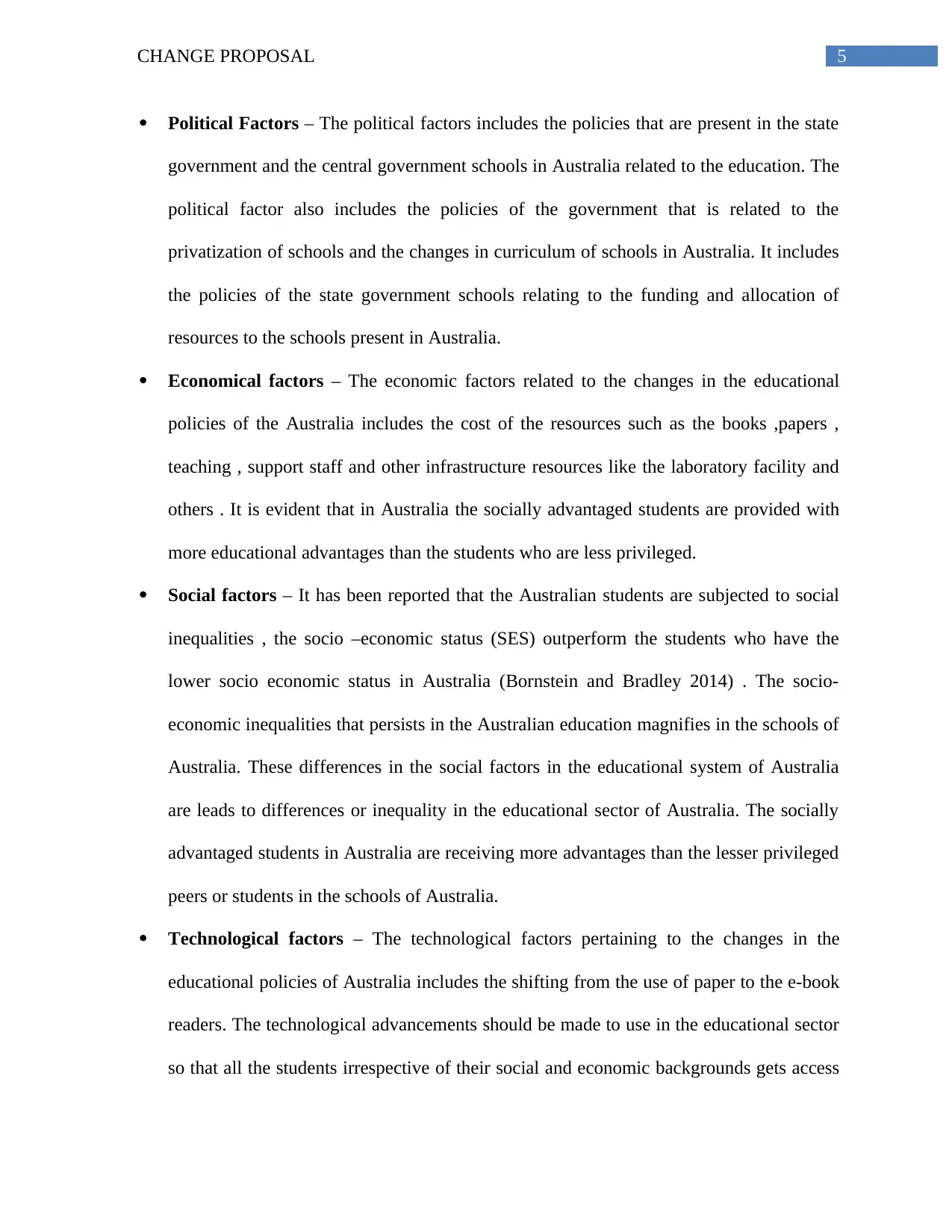
5CHANGE PROPOSAL
Political Factors – The political factors includes the policies that are present in the state
government and the central government schools in Australia related to the education. The
political factor also includes the policies of the government that is related to the
privatization of schools and the changes in curriculum of schools in Australia. It includes
the policies of the state government schools relating to the funding and allocation of
resources to the schools present in Australia.
Economical factors – The economic factors related to the changes in the educational
policies of the Australia includes the cost of the resources such as the books ,papers ,
teaching , support staff and other infrastructure resources like the laboratory facility and
others . It is evident that in Australia the socially advantaged students are provided with
more educational advantages than the students who are less privileged.
Social factors – It has been reported that the Australian students are subjected to social
inequalities , the socio –economic status (SES) outperform the students who have the
lower socio economic status in Australia (Bornstein and Bradley 2014) . The socio-
economic inequalities that persists in the Australian education magnifies in the schools of
Australia. These differences in the social factors in the educational system of Australia
are leads to differences or inequality in the educational sector of Australia. The socially
advantaged students in Australia are receiving more advantages than the lesser privileged
peers or students in the schools of Australia.
Technological factors – The technological factors pertaining to the changes in the
educational policies of Australia includes the shifting from the use of paper to the e-book
readers. The technological advancements should be made to use in the educational sector
so that all the students irrespective of their social and economic backgrounds gets access
Political Factors – The political factors includes the policies that are present in the state
government and the central government schools in Australia related to the education. The
political factor also includes the policies of the government that is related to the
privatization of schools and the changes in curriculum of schools in Australia. It includes
the policies of the state government schools relating to the funding and allocation of
resources to the schools present in Australia.
Economical factors – The economic factors related to the changes in the educational
policies of the Australia includes the cost of the resources such as the books ,papers ,
teaching , support staff and other infrastructure resources like the laboratory facility and
others . It is evident that in Australia the socially advantaged students are provided with
more educational advantages than the students who are less privileged.
Social factors – It has been reported that the Australian students are subjected to social
inequalities , the socio –economic status (SES) outperform the students who have the
lower socio economic status in Australia (Bornstein and Bradley 2014) . The socio-
economic inequalities that persists in the Australian education magnifies in the schools of
Australia. These differences in the social factors in the educational system of Australia
are leads to differences or inequality in the educational sector of Australia. The socially
advantaged students in Australia are receiving more advantages than the lesser privileged
peers or students in the schools of Australia.
Technological factors – The technological factors pertaining to the changes in the
educational policies of Australia includes the shifting from the use of paper to the e-book
readers. The technological advancements should be made to use in the educational sector
so that all the students irrespective of their social and economic backgrounds gets access
⊘ This is a preview!⊘
Do you want full access?
Subscribe today to unlock all pages.

Trusted by 1+ million students worldwide
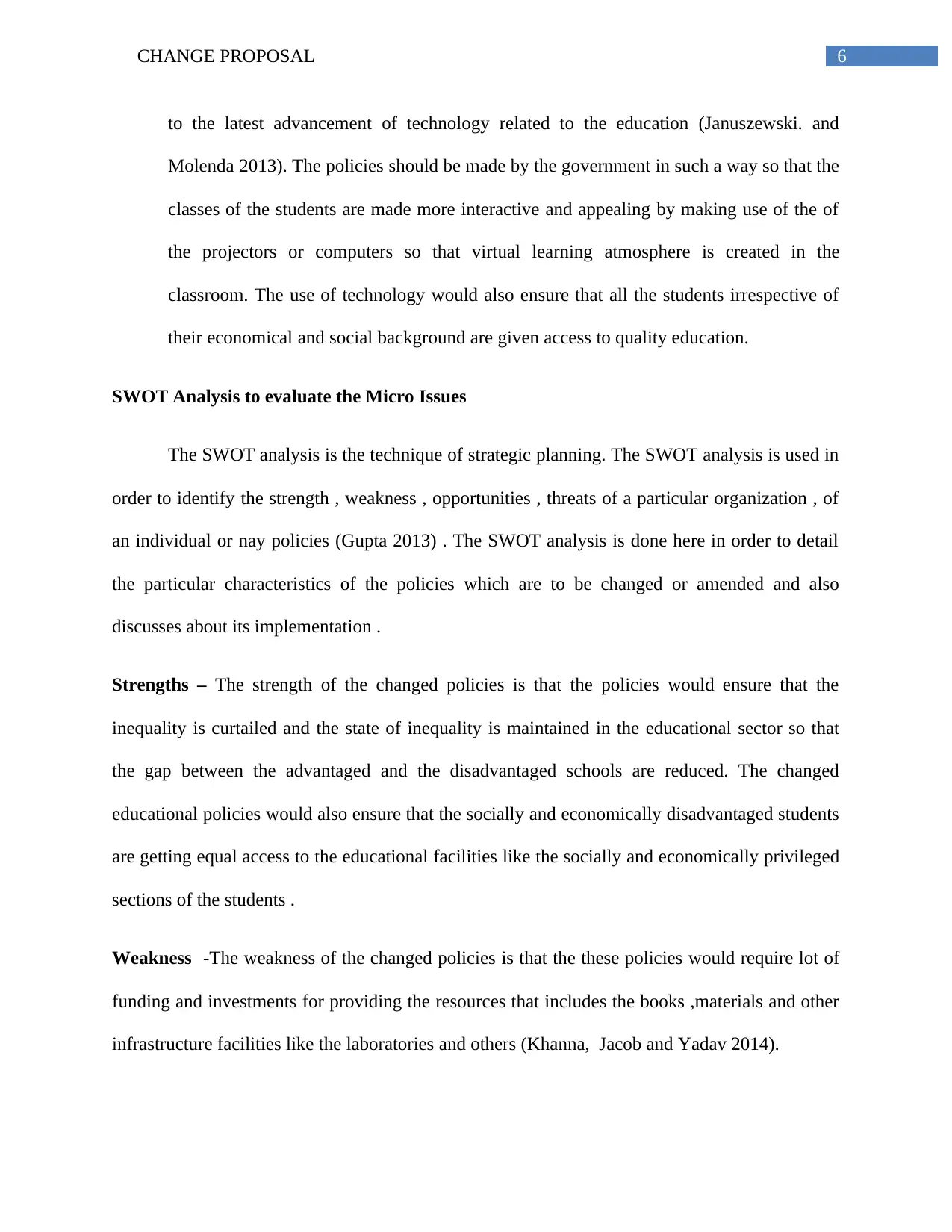
6CHANGE PROPOSAL
to the latest advancement of technology related to the education (Januszewski. and
Molenda 2013). The policies should be made by the government in such a way so that the
classes of the students are made more interactive and appealing by making use of the of
the projectors or computers so that virtual learning atmosphere is created in the
classroom. The use of technology would also ensure that all the students irrespective of
their economical and social background are given access to quality education.
SWOT Analysis to evaluate the Micro Issues
The SWOT analysis is the technique of strategic planning. The SWOT analysis is used in
order to identify the strength , weakness , opportunities , threats of a particular organization , of
an individual or nay policies (Gupta 2013) . The SWOT analysis is done here in order to detail
the particular characteristics of the policies which are to be changed or amended and also
discusses about its implementation .
Strengths – The strength of the changed policies is that the policies would ensure that the
inequality is curtailed and the state of inequality is maintained in the educational sector so that
the gap between the advantaged and the disadvantaged schools are reduced. The changed
educational policies would also ensure that the socially and economically disadvantaged students
are getting equal access to the educational facilities like the socially and economically privileged
sections of the students .
Weakness -The weakness of the changed policies is that the these policies would require lot of
funding and investments for providing the resources that includes the books ,materials and other
infrastructure facilities like the laboratories and others (Khanna, Jacob and Yadav 2014).
to the latest advancement of technology related to the education (Januszewski. and
Molenda 2013). The policies should be made by the government in such a way so that the
classes of the students are made more interactive and appealing by making use of the of
the projectors or computers so that virtual learning atmosphere is created in the
classroom. The use of technology would also ensure that all the students irrespective of
their economical and social background are given access to quality education.
SWOT Analysis to evaluate the Micro Issues
The SWOT analysis is the technique of strategic planning. The SWOT analysis is used in
order to identify the strength , weakness , opportunities , threats of a particular organization , of
an individual or nay policies (Gupta 2013) . The SWOT analysis is done here in order to detail
the particular characteristics of the policies which are to be changed or amended and also
discusses about its implementation .
Strengths – The strength of the changed policies is that the policies would ensure that the
inequality is curtailed and the state of inequality is maintained in the educational sector so that
the gap between the advantaged and the disadvantaged schools are reduced. The changed
educational policies would also ensure that the socially and economically disadvantaged students
are getting equal access to the educational facilities like the socially and economically privileged
sections of the students .
Weakness -The weakness of the changed policies is that the these policies would require lot of
funding and investments for providing the resources that includes the books ,materials and other
infrastructure facilities like the laboratories and others (Khanna, Jacob and Yadav 2014).
Paraphrase This Document
Need a fresh take? Get an instant paraphrase of this document with our AI Paraphraser
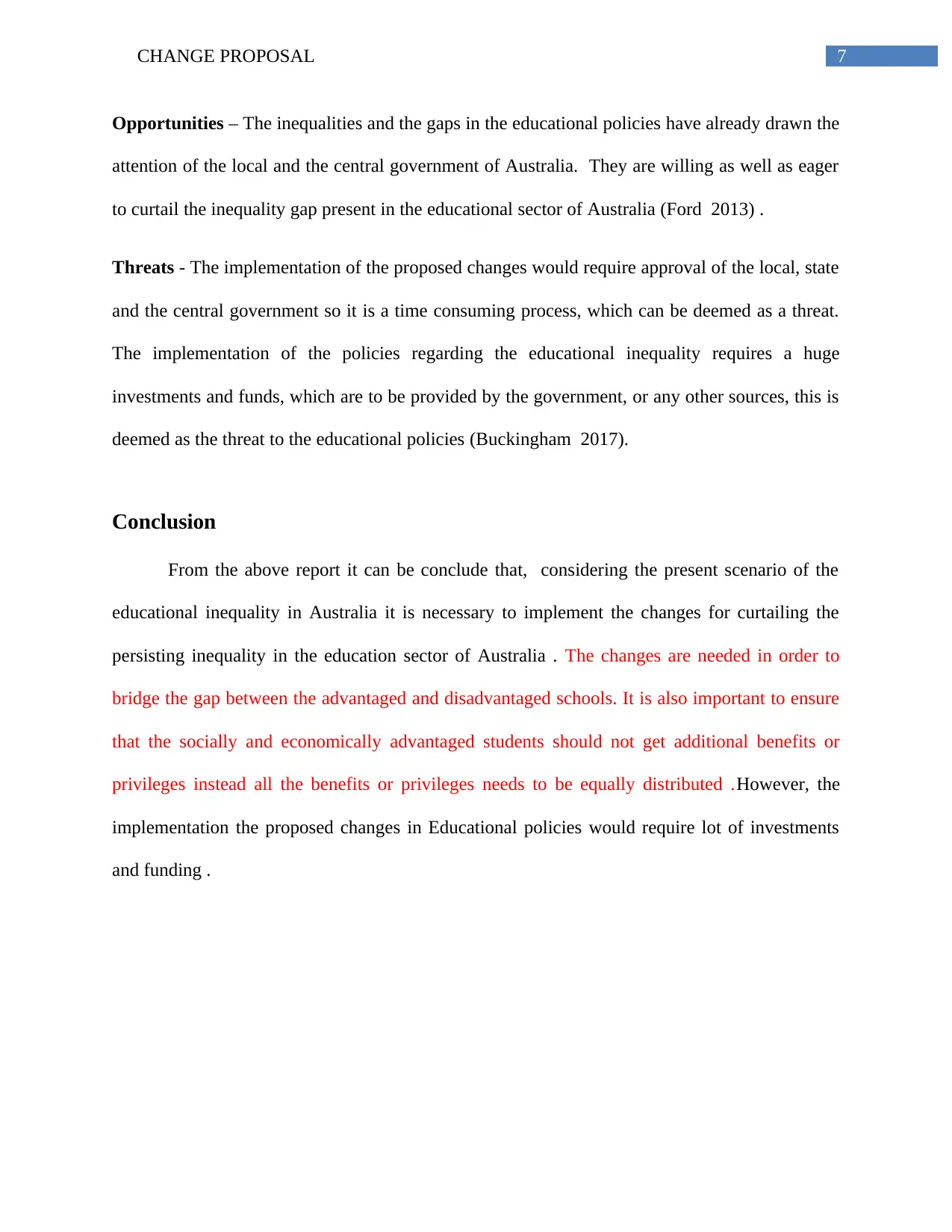
7CHANGE PROPOSAL
Opportunities – The inequalities and the gaps in the educational policies have already drawn the
attention of the local and the central government of Australia. They are willing as well as eager
to curtail the inequality gap present in the educational sector of Australia (Ford 2013) .
Threats - The implementation of the proposed changes would require approval of the local, state
and the central government so it is a time consuming process, which can be deemed as a threat.
The implementation of the policies regarding the educational inequality requires a huge
investments and funds, which are to be provided by the government, or any other sources, this is
deemed as the threat to the educational policies (Buckingham 2017).
Conclusion
From the above report it can be conclude that, considering the present scenario of the
educational inequality in Australia it is necessary to implement the changes for curtailing the
persisting inequality in the education sector of Australia . The changes are needed in order to
bridge the gap between the advantaged and disadvantaged schools. It is also important to ensure
that the socially and economically advantaged students should not get additional benefits or
privileges instead all the benefits or privileges needs to be equally distributed .However, the
implementation the proposed changes in Educational policies would require lot of investments
and funding .
Opportunities – The inequalities and the gaps in the educational policies have already drawn the
attention of the local and the central government of Australia. They are willing as well as eager
to curtail the inequality gap present in the educational sector of Australia (Ford 2013) .
Threats - The implementation of the proposed changes would require approval of the local, state
and the central government so it is a time consuming process, which can be deemed as a threat.
The implementation of the policies regarding the educational inequality requires a huge
investments and funds, which are to be provided by the government, or any other sources, this is
deemed as the threat to the educational policies (Buckingham 2017).
Conclusion
From the above report it can be conclude that, considering the present scenario of the
educational inequality in Australia it is necessary to implement the changes for curtailing the
persisting inequality in the education sector of Australia . The changes are needed in order to
bridge the gap between the advantaged and disadvantaged schools. It is also important to ensure
that the socially and economically advantaged students should not get additional benefits or
privileges instead all the benefits or privileges needs to be equally distributed .However, the
implementation the proposed changes in Educational policies would require lot of investments
and funding .
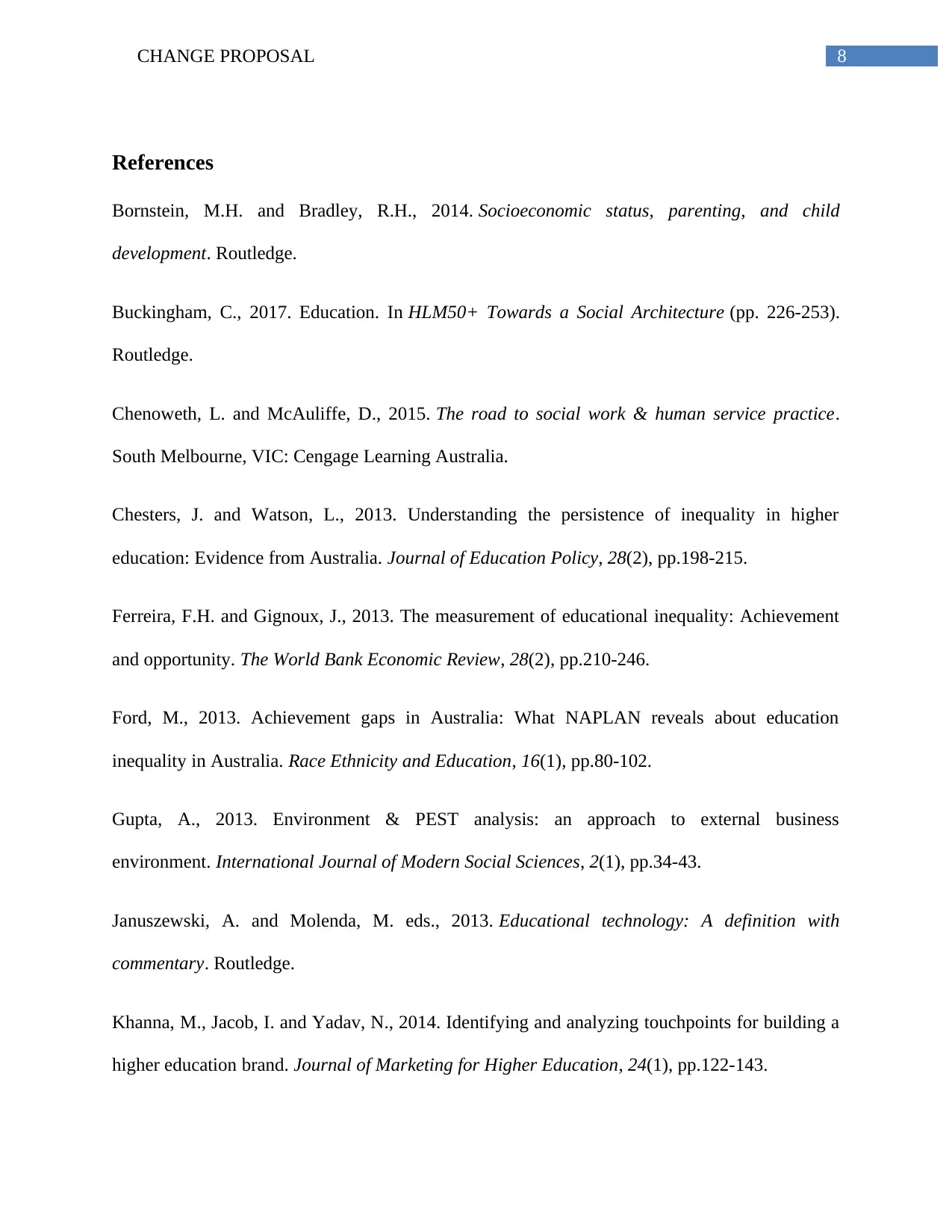
8CHANGE PROPOSAL
References
Bornstein, M.H. and Bradley, R.H., 2014. Socioeconomic status, parenting, and child
development. Routledge.
Buckingham, C., 2017. Education. In HLM50+ Towards a Social Architecture (pp. 226-253).
Routledge.
Chenoweth, L. and McAuliffe, D., 2015. The road to social work & human service practice.
South Melbourne, VIC: Cengage Learning Australia.
Chesters, J. and Watson, L., 2013. Understanding the persistence of inequality in higher
education: Evidence from Australia. Journal of Education Policy, 28(2), pp.198-215.
Ferreira, F.H. and Gignoux, J., 2013. The measurement of educational inequality: Achievement
and opportunity. The World Bank Economic Review, 28(2), pp.210-246.
Ford, M., 2013. Achievement gaps in Australia: What NAPLAN reveals about education
inequality in Australia. Race Ethnicity and Education, 16(1), pp.80-102.
Gupta, A., 2013. Environment & PEST analysis: an approach to external business
environment. International Journal of Modern Social Sciences, 2(1), pp.34-43.
Januszewski, A. and Molenda, M. eds., 2013. Educational technology: A definition with
commentary. Routledge.
Khanna, M., Jacob, I. and Yadav, N., 2014. Identifying and analyzing touchpoints for building a
higher education brand. Journal of Marketing for Higher Education, 24(1), pp.122-143.
References
Bornstein, M.H. and Bradley, R.H., 2014. Socioeconomic status, parenting, and child
development. Routledge.
Buckingham, C., 2017. Education. In HLM50+ Towards a Social Architecture (pp. 226-253).
Routledge.
Chenoweth, L. and McAuliffe, D., 2015. The road to social work & human service practice.
South Melbourne, VIC: Cengage Learning Australia.
Chesters, J. and Watson, L., 2013. Understanding the persistence of inequality in higher
education: Evidence from Australia. Journal of Education Policy, 28(2), pp.198-215.
Ferreira, F.H. and Gignoux, J., 2013. The measurement of educational inequality: Achievement
and opportunity. The World Bank Economic Review, 28(2), pp.210-246.
Ford, M., 2013. Achievement gaps in Australia: What NAPLAN reveals about education
inequality in Australia. Race Ethnicity and Education, 16(1), pp.80-102.
Gupta, A., 2013. Environment & PEST analysis: an approach to external business
environment. International Journal of Modern Social Sciences, 2(1), pp.34-43.
Januszewski, A. and Molenda, M. eds., 2013. Educational technology: A definition with
commentary. Routledge.
Khanna, M., Jacob, I. and Yadav, N., 2014. Identifying and analyzing touchpoints for building a
higher education brand. Journal of Marketing for Higher Education, 24(1), pp.122-143.
⊘ This is a preview!⊘
Do you want full access?
Subscribe today to unlock all pages.

Trusted by 1+ million students worldwide
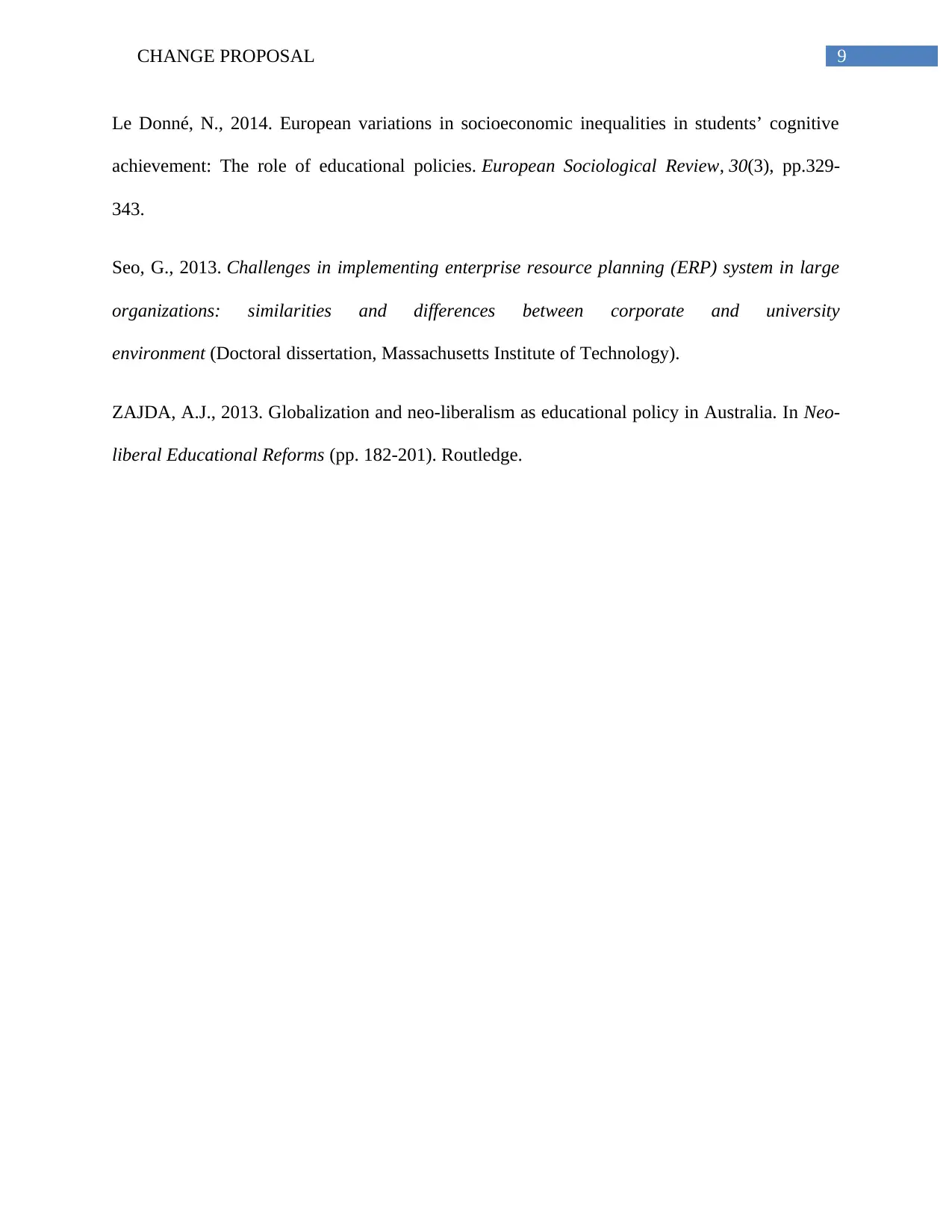
9CHANGE PROPOSAL
Le Donné, N., 2014. European variations in socioeconomic inequalities in students’ cognitive
achievement: The role of educational policies. European Sociological Review, 30(3), pp.329-
343.
Seo, G., 2013. Challenges in implementing enterprise resource planning (ERP) system in large
organizations: similarities and differences between corporate and university
environment (Doctoral dissertation, Massachusetts Institute of Technology).
ZAJDA, A.J., 2013. Globalization and neo-liberalism as educational policy in Australia. In Neo-
liberal Educational Reforms (pp. 182-201). Routledge.
Le Donné, N., 2014. European variations in socioeconomic inequalities in students’ cognitive
achievement: The role of educational policies. European Sociological Review, 30(3), pp.329-
343.
Seo, G., 2013. Challenges in implementing enterprise resource planning (ERP) system in large
organizations: similarities and differences between corporate and university
environment (Doctoral dissertation, Massachusetts Institute of Technology).
ZAJDA, A.J., 2013. Globalization and neo-liberalism as educational policy in Australia. In Neo-
liberal Educational Reforms (pp. 182-201). Routledge.
1 out of 10
Related Documents
Your All-in-One AI-Powered Toolkit for Academic Success.
+13062052269
info@desklib.com
Available 24*7 on WhatsApp / Email
![[object Object]](/_next/static/media/star-bottom.7253800d.svg)
Unlock your academic potential
Copyright © 2020–2025 A2Z Services. All Rights Reserved. Developed and managed by ZUCOL.





